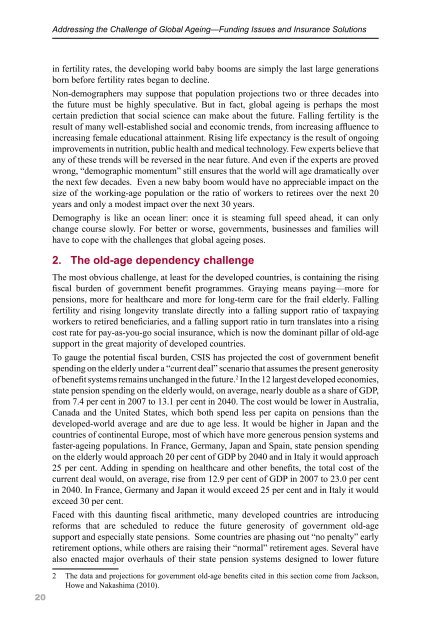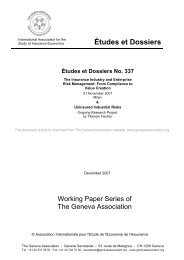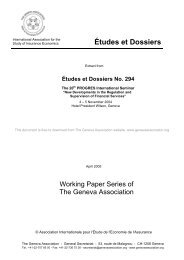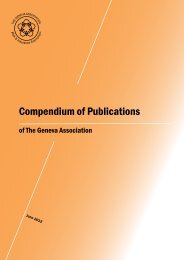Addressing the Challenge of Global Ageing?Funding Issues and
Addressing the Challenge of Global Ageing?Funding Issues and
Addressing the Challenge of Global Ageing?Funding Issues and
Create successful ePaper yourself
Turn your PDF publications into a flip-book with our unique Google optimized e-Paper software.
20<br />
<strong>Addressing</strong> <strong>the</strong> <strong>Challenge</strong> <strong>of</strong> <strong>Global</strong> <strong>Ageing</strong>—<strong>Funding</strong> <strong>Issues</strong> <strong>and</strong> Insurance Solutions<br />
in fertility rates, <strong>the</strong> developing world baby booms are simply <strong>the</strong> last large generations<br />
born before fertility rates began to decline.<br />
Non-demographers may suppose that population projections two or three decades into<br />
<strong>the</strong> future must be highly speculative. But in fact, global ageing is perhaps <strong>the</strong> most<br />
certain prediction that social science can make about <strong>the</strong> future. Falling fertility is <strong>the</strong><br />
result <strong>of</strong> many well-established social <strong>and</strong> economic trends, from increasing affluence to<br />
increasing female educational attainment. Rising life expectancy is <strong>the</strong> result <strong>of</strong> ongoing<br />
improvements in nutrition, public health <strong>and</strong> medical technology. Few experts believe that<br />
any <strong>of</strong> <strong>the</strong>se trends will be reversed in <strong>the</strong> near future. And even if <strong>the</strong> experts are proved<br />
wrong, “demographic momentum” still ensures that <strong>the</strong> world will age dramatically over<br />
<strong>the</strong> next few decades. Even a new baby boom would have no appreciable impact on <strong>the</strong><br />
size <strong>of</strong> <strong>the</strong> working-age population or <strong>the</strong> ratio <strong>of</strong> workers to retirees over <strong>the</strong> next 20<br />
years <strong>and</strong> only a modest impact over <strong>the</strong> next 30 years.<br />
Demography is like an ocean liner: once it is steaming full speed ahead, it can only<br />
change course slowly. For better or worse, governments, businesses <strong>and</strong> families will<br />
have to cope with <strong>the</strong> challenges that global ageing poses.<br />
2. The old-age dependency challenge<br />
The most obvious challenge, at least for <strong>the</strong> developed countries, is containing <strong>the</strong> rising<br />
fiscal burden <strong>of</strong> government benefit programmes. Graying means paying—more for<br />
pensions, more for healthcare <strong>and</strong> more for long-term care for <strong>the</strong> frail elderly. Falling<br />
fertility <strong>and</strong> rising longevity translate directly into a falling support ratio <strong>of</strong> taxpaying<br />
workers to retired beneficiaries, <strong>and</strong> a falling support ratio in turn translates into a rising<br />
cost rate for pay-as-you-go social insurance, which is now <strong>the</strong> dominant pillar <strong>of</strong> old-age<br />
support in <strong>the</strong> great majority <strong>of</strong> developed countries.<br />
To gauge <strong>the</strong> potential fiscal burden, CSIS has projected <strong>the</strong> cost <strong>of</strong> government benefit<br />
spending on <strong>the</strong> elderly under a “current deal” scenario that assumes <strong>the</strong> present generosity<br />
<strong>of</strong> benefit systems remains unchanged in <strong>the</strong> future. 2 In <strong>the</strong> 12 largest developed economies,<br />
state pension spending on <strong>the</strong> elderly would, on average, nearly double as a share <strong>of</strong> GDP,<br />
from 7.4 per cent in 2007 to 13.1 per cent in 2040. The cost would be lower in Australia,<br />
Canada <strong>and</strong> <strong>the</strong> United States, which both spend less per capita on pensions than <strong>the</strong><br />
developed-world average <strong>and</strong> are due to age less. It would be higher in Japan <strong>and</strong> <strong>the</strong><br />
countries <strong>of</strong> continental Europe, most <strong>of</strong> which have more generous pension systems <strong>and</strong><br />
faster-ageing populations. In France, Germany, Japan <strong>and</strong> Spain, state pension spending<br />
on <strong>the</strong> elderly would approach 20 per cent <strong>of</strong> GDP by 2040 <strong>and</strong> in Italy it would approach<br />
25 per cent. Adding in spending on healthcare <strong>and</strong> o<strong>the</strong>r benefits, <strong>the</strong> total cost <strong>of</strong> <strong>the</strong><br />
current deal would, on average, rise from 12.9 per cent <strong>of</strong> GDP in 2007 to 23.0 per cent<br />
in 2040. In France, Germany <strong>and</strong> Japan it would exceed 25 per cent <strong>and</strong> in Italy it would<br />
exceed 30 per cent.<br />
Faced with this daunting fiscal arithmetic, many developed countries are introducing<br />
reforms that are scheduled to reduce <strong>the</strong> future generosity <strong>of</strong> government old-age<br />
support <strong>and</strong> especially state pensions. Some countries are phasing out “no penalty” early<br />
retirement options, while o<strong>the</strong>rs are raising <strong>the</strong>ir “normal” retirement ages. Several have<br />
also enacted major overhauls <strong>of</strong> <strong>the</strong>ir state pension systems designed to lower future<br />
2 The data <strong>and</strong> projections for government old-age benefits cited in this section come from Jackson,<br />
Howe <strong>and</strong> Nakashima (2010).








